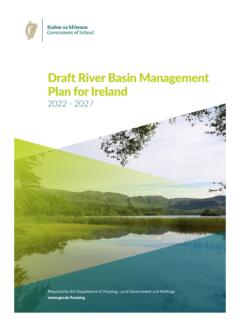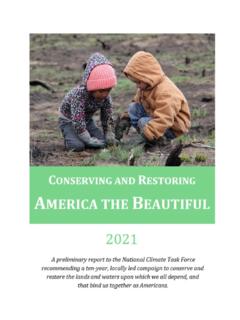Transcription of England Peat Action Plan - GOV.UK
1 England Peat Action plan May 2021 Butterburn Flow. Iain Diack Crown copyright 2021 This publication is licensed under the terms of the Open Government Licence except where otherwise stated. To view this licence, visit Where we have identified any third party copyright information you will need to obtain permission from the copyright holders concerned. This publication is available at Any enquiries regarding this publication should be sent to us at PB 14668 05/21 Printed on paper containing 75% recycled fibre content minimum Printed in the UK by the APS Group on behalf of the Controller of Her Majesty s Stationery Office 1 Contents Ministerial foreword 2 Executive summary 4 Our Goals 4 How we will achieve this 5 What we will deliver 5 How we will measure success 6 Next steps 6 Chapter 1: The case to restore our peatlands 7 Chapter 2: The plan to restore our peatlands 11 Future vision 11 Unlocking Private Finance 13 Locking in the benefits 14 Chapter 3: The plan to reduce degradation 15 Future vision 15 Delivering for peatland and trees 17 Chapter 4: The plan to protect our peatland 19 Future vision: horticultural peat 19 Future vision: protecting peatland from fire 21 Future vision: planning & development 24 Chapter 5.
2 Driving progress 25 Annex A: Unlocking private finance 27 Annex B: Protecting peat 31 Annex C: Delivery Approach 34 Ministerial foreword Our peatlands are an iconic feature of England s landscape. Often referred to as our national rainforest , they perform many functions they are our largest terrestrial carbon store, a haven for rarewildlife, a record of our past, and natural providers of waterregulation. Yet, for too long we have taken this valuable naturalresource for granted. Only 13% of England s peatlands are in anear natural Action plan sets out our vision to reverse this decline. Our aim is to prevent further loss of peatland habitats and to restore more peatland landscapes to their natural state. Re-wetting peatland areas and returning them to their natural state could make a significant contribution to achieving our targets on reducing carbon emissions, as well as having other benefits for water quality, nature and flood mitigation.
3 The essence of our approach is to use new funds, like the Nature for Climate Fund and our schemes that reward farmers and land managers for producing public goods, as well as private finance to support a change in the management of these landscapes. We have invested over 8million in peatland restoration in 2020/21. We recently launched our four-year Nature for Climate Peatland Grant Scheme. We intend to invest over 50million in peatland restoration by 2025. In areas like the Pennines, we will be developing incentives under the future agriculture policy to support projects that deliver both the capital required to achieve re-wetting of land coupled with maintenance payments to preserve it for the future. We will also be exploring the role of Conservation Covenants, introduced in the new Humberhead Levels, Thorne Moors. Natural England3 Environment Bill, to link to these incentives; so that the habitats we rebuild are linked to long term undertakings.
4 Northern England s sweeping expanse of blanket bog an internationally rare habitat will be an early priority for restoration, to help us protect this global asset. Alongside this Action plan , we are announcing a number of early Nature for Climate Fund investments in 2020/21, including an investment in the Great North Bog, a landscape approach to restoration across nearly 7,000 square kilometres of upland peat in the Protected Landscapes of northern England . The initiative will secure a significant carbon store, provide a bigger and better-connected habitat for rare peatland species, contribute to the Nature Recovery Network, preserve and enhance our most precious heritage peatland sites, and will reduce the impact of flooding in communities downstream from the restored peatland. The Fenland agricultural soils in lowland areas like Cambridgeshire are our country s most productive soils.
5 They are the breadbasket of the UK, producing some of our most important horticultural crops. However, these vital assets are also in decline. As a student in commercial horticulture in the early 1990s, I recall visiting the Cambridgeshire fens and observing how soil levels had dropped in preceding decades, as the land had oxidised and broken down through relentless cropping. We now know that in addition to degrading these soils, that process also releases a significant amount of carbon into the atmosphere. Therefore, we are establishing a task force to explore how the husbandry of these crucial agricultural soils might be improved, to reduce and mitigate the loss of these assets. In recent decades, progress has also been made in developing alternatives to the use of peat in horticulture, with the consistency of substitutes like coir improving. Peatland soils and the habitats they support should be nurtured, not mined, and this Action plan sets out measures to accelerate the switch to the use of alternatives, starting first with bans on the sale of peat for amateur use by the end of this parliament, and gradually moving to alternatives for other commercial sectors over time.
6 The government has also introduced measures placing further restrictions on the burning of heather on blanket bog. While the intrinsic carbon emissions from such activity are fairly low, such practices act as an impediment to the wider restoration of peatland habitats and their hydrology, and therefore prevent carbon abatement. We recognise that there are inaccessible areas where the use of cutting equipment is presently not practical and where some burning may be required, so we have included exemptions on steep land and the ability to seek a licence from the government in certain limited circumstances. Finally, we want this Action plan to be an endeavour that engages all the relevant parties and, in particular, the landowners who have been custodians of these iconic landscapes for centuries. While delivering the objectives of this Action plan will require change, the government stands ready to put in place the right policies and incentives that ensure we can all work together to achieve our shared goals.
7 George Eustice, Secretary of State for Environment, Food and Rural Affairs Executive summary Our Goals The 25 Year Environment plan set out our ambition to create and deliver a new ambitious framework for peat restoration in England . Peatland restoration will enable our peatlands not only to meet their Net Zero contribution, but also contribute to wider environmental goals. Where it is not appropriate to restore lowland peat, we will develop new responsible management measures to make sure that the topsoil is retained for as long as possible and greenhouse gas emissions are reduced. We want our peatland to meet the needs of wildlife , people and the planet. All uses of peatland should keep the peat wet and in the ground. We will work to ensure all our peatlands, not just deep or protected peat, are responsibly managed,1 or, in good hydrological condition or under restoration will 1 Responsible management in this context is management activity that does not seek to re-establish peat habitats, but which significantly reduces the impact of using peatland for that purpose.
8 It is for situations where full restoration is not feasible. The term needs further definition and will be land use specific. In lowland agricultural peatlands this is likely to involve changed water management and has the potential to significantly reduce greenhouse gas emissions and reduce the loss of soil, whilst offering farmers the opportunity to innovate and explore new markets. 2 Peatland restoration should be regarded as a process and not as a one-off restoration event. Peatland sites that have been subject to restoration activity should not immediately be described as restored (or in good hydrological condition). The restoration process will have been started, but the natural system will take time to recover and achieve restored status. In the meantime, these peatlands can be described as being under restoration management as long as ongoing management practices are sympathetic to the restoration end goal and allow the site to continue on its restoration trajectory.
9 Red Moss SSSI, Greater Manchester. Natural England / Peter Wakely 5 set a target for peatland restoration as part of the forthcoming Net Zero Strategy, recognising the important role that peat plays in the pathway to net zero emissions. How we will achieve this We will develop a more up to date and detailed England peat map by 2024, establishing a clear evidence base on which to build. We will immediately fund at least 35,000 ha of peatland restoration by 2025, through the Nature for Climate Fund and other sources. This is just the start of our ambition for peatland restoration to 2050 and beyond. The government s new Sustainable Farming Incentive, Local Nature Recovery and Landscape Recovery Schemes will provide the main delivery mechanism for peatland restoration after 2024-25 and our new Nature for Climate grants will act as an important precursor. By Summer 2022, we will have recommendations for a more sustainable future for our lowland agricultural peatlands, developed by the Lowland Agricultural Peat Task Force.
10 Where the environmental benefits are clear, the delivery of these recommendations may be supported through new schemes that reward farmers and land managers for producing public goods; the sale of peatland carbon credits; and better regulation. We will consult on banning the sale of peat and peat containing products in the amateur sector by the end of this parliament. We will publish a full consultation on phasing out the use of peat in horticulture in 2021. We recognise that the voluntary approach has not delivered. We will continue to protect our peat from fire by both phasing out managed burning and reducing the risk of wildfire. What we will deliver Implementation of the measures above will: Secure our peatlands carbon store so they meet their contribution to Net Zero by 2050. This cannot be achieved by only restoring upland peat but will require significant changes to how we manage our lowland peat.











